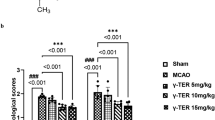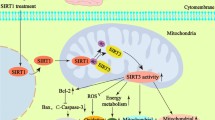Abstract
Previous studies found that electroacupuncture (EA) at the Shenting (DU24) and Baihui (DU20) acupoints alleviates cognitive impairment in cerebral ischemia–reperfusion (I/R) injury rats. Nonetheless, the mechanisms of the anti-inflammatory effects of EA are unclear. Cerebral I/R injury was induced in rats by middle cerebral artery occlusion (MCAO). Following I/R injury, the rats underwent EA therapy at the Shenting (DU24) and Baihui (DU20) acupoints for seven successive days. The Morris water maze test, magnetic resonance imaging (MRI) and molecular biology assays were utilized to assess the establishment of the rat stroke model with cognitive impairment and the therapeutic effect of EA. EA treatment of rats subjected to MCAO showed a significant reduction in infarct volumes accompanied by cognitive recovery, as observed in Morris water maze test outcomes. The possible mechanisms by which EA treatment attenuates cognitive impairment are by regulating endogenous melatonin secretion through aralkylamine N-acetyltransferase gene (AANAT, a rate-limiting enzyme of melatonin) synthesis in the pineal gland in stroke rats. Simultaneously, through melatonin regulation, EA exerts neuroprotective effects by upregulating mitophagy-associated proteins and suppressing reactive oxygen species (ROS)-induced NLRP3 inflammasome activation after I/R injury. However, melatonin receptor inhibitor (luzindole) treatment reversed these changes. The findings from this research suggested that EA ameliorates cognitive impairment through the inhibition of NLRP3 inflammasome activation by regulating melatonin-mediated mitophagy in stroke rats.







Similar content being viewed by others
Data Availability
The data used to support the findings of this study are included in the article.
Change history
31 March 2022
A Correction to this paper has been published: https://doi.org/10.1007/s11064-022-03590-4
References
Liu J, Zheng L, Cheng Y, Zhang S, Wu B, Wang D, Zhang S, Tao W, Wu S, Liu M (2019) Trends in outcomes of patients with ischemic stroke treated between 2002 and 2016: insights from a Chinese cohort. Circ Cardiovasc Qual Outcomes 12:e005610. https://doi.org/10.1161/circoutcomes.119.005610
Amarenco P, Bogousslavsky J, Caplan LR, Donnan GA, Hennerici MG (2009) Classification of stroke subtypes. Cerebrovasc Dis 27:493–501. https://doi.org/10.1159/000210432
Pasi M, Poggesi A, Salvadori E, Pantoni L (2012) Post-stroke dementia and cognitive impairment. Front Neurol Neurosci 30:65–69. https://doi.org/10.1159/000333412
Zheng G, Liu F, Li S, Huang M, Tao J, Chen L (2015) Tai Chi and the protection of cognitive ability: a systematic review of prospective studies in healthy adults. Am J Prev Med 49:89–97. https://doi.org/10.1016/j.amepre.2015.01.002
Liu F, Li ZM, Jiang YJ, Chen LD (2014) A meta-analysis of acupuncture use in the treatment of cognitive impairment after stroke. J Altern Complement Med 20:535–544. https://doi.org/10.1089/acm.2013.0364
Zhou L, Wang Y, Qiao J, Wang QM, Luo X (2020) Acupuncture for improving cognitive impairment after stroke: a meta-analysis of randomized controlled trials. Front Psychol 11:549265. https://doi.org/10.3389/fpsyg.2020.549265
Feng X, Yang S, Liu J, Huang J, Peng J, Lin J, Tao J, Chen L (2013) Electroacupuncture ameliorates cognitive impairment through inhibition of NF-κB-mediated neuronal cell apoptosis in cerebral ischemia-reperfusion injured rats. Mol Med Rep 7:1516–1522. https://doi.org/10.3892/mmr.2013.1392
Lin R, Li X, Liu W, Chen W, Yu K, Zhao C, Huang J, Yang S, Peng H, Tao J, Chen L (2017) Electro-acupuncture ameliorates cognitive impairment via improvement of brain-derived neurotropic factor-mediated hippocampal synaptic plasticity in cerebral ischemia-reperfusion injured rats. Exp Ther Med 14:2373–2379. https://doi.org/10.3892/etm.2017.4750
Lin R, Lin Y, Tao J, Chen B, Yu K, Chen J, Li X, Chen LD (2015) Electroacupuncture ameliorates learning and memory in rats with cerebral ischemia-reperfusion injury by inhibiting oxidative stress and promoting p-CREB expression in the hippocampus. Mol Med Rep 12:6807–6814. https://doi.org/10.3892/mmr.2015.4321
Fann DY, Lee SY, Manzanero S et al (2013) Intravenous immunoglobulin suppresses NLRP1 and NLRP3 inflammasome-mediated neuronal death in ischemic stroke. Cell Death Dis 4:e790. https://doi.org/10.1038/cddis.2013.326
Ma Q, Chen S, Hu Q, Feng H, Zhang JH, Tang J (2014) NLRP3 inflammasome contributes to inflammation after intracerebral hemorrhage. Ann Neurol 75:209–219. https://doi.org/10.1002/ana.24070
Zhao S, Li X, Wang J, Wang H (2021) The role of the effects of autophagy on NLRP3 inflammasome in inflammatory nervous system diseases. Front Cell Dev Biol 9:657478. https://doi.org/10.3389/fcell.2021.657478
Schroder K, Tschopp J (2010) The inflammasomes. Cell 140:821–832. https://doi.org/10.1016/j.cell.2010.01.040
Cao S, Shrestha S, Li J, Yu X, Chen J, Yan F, Ying G, Gu C, Wang L, Chen G (2017) Melatonin-mediated mitophagy protects against early brain injury after subarachnoid hemorrhage through inhibition of NLRP3 inflammasome activation. Sci Rep 7:2417. https://doi.org/10.1038/s41598-017-02679-z
Sun R, Peng M, Xu P, Huang F, Xie Y, Li J, Hong Y, Guo H, Liu Q, Zhu W (2020) Low-density lipoprotein receptor (LDLR) regulates NLRP3-mediated neuronal pyroptosis following cerebral ischemia/reperfusion injury. J Neuroinflammation 17:330. https://doi.org/10.1186/s12974-020-01988-x
Li YQ, Chen JX, Li QW, Xiao ZJ, Yuan T, Xie ZH (2020) Targeting NLRP3 inflammasome improved the neurogenesis and post-stroke cognition in a mouse model of photothrombotic stroke. NeuroReport 31:806–813. https://doi.org/10.1097/wnr.0000000000001489
Zhou R, Yazdi AS, Menu P, Tschopp J (2011) A role for mitochondria in NLRP3 inflammasome activation. Nature 469:221–225. https://doi.org/10.1038/nature09663
Murphy MP (2009) How mitochondria produce reactive oxygen species. Biochem J 417:1–13. https://doi.org/10.1042/bj20081386
He J, Liu J, Huang Y, Tang X, Xiao H, Hu Z (2021) Oxidative stress, inflammation, and autophagy: potential targets of mesenchymal stem cells-based therapies in ischemic stroke. Front Neurosci 15:641157. https://doi.org/10.3389/fnins.2021.641157
Jia J, Jin H, Nan D, Yu W, Huang Y (2021) New insights into targeting mitochondria in ischemic injury. Apoptosis 26:163–183. https://doi.org/10.1007/s10495-021-01661-5
Poznyak AV, Melnichenko AA, Wetzker R, Gerasimova EV, Orekhov AN (2020) NLPR3 inflammasomes and their significance for atherosclerosis. Biomedicines 8:205. https://doi.org/10.3390/biomedicines8070205
Youle RJ, Narendra DP (2011) Mechanisms of mitophagy. Nat Rev Mol Cell Biol 12:9–14. https://doi.org/10.1038/nrm3028
Andrabi SS, Parvez S, Tabassum H (2015) Melatonin and ischemic stroke: mechanistic roles and action. Adv Pharmacol Sci 2015:384750. https://doi.org/10.1155/2015/384750
Lee CH, Park JH, Ahn JH, Won MH (2016) Effects of melatonin on cognitive impairment and hippocampal neuronal damage in a rat model of chronic cerebral hypoperfusion. Exp Ther Med 11:2240–2246. https://doi.org/10.3892/etm.2016.3216
Tsai TH, Lin CJ, Chua S, Chung SY, Yang CH, Tong MS, Hang CL (2017) Melatonin attenuated the brain damage and cognitive impairment partially through MT2 melatonin receptor in mice with chronic cerebral hypoperfusion. Oncotarget 8:74320–74330. https://doi.org/10.18632/oncotarget.20382
Farhadi N, Gharghani M, Farhadi Z (2016) Effects of long-term light, darkness and oral administration of melatonin on serum levels of melatonin. Biomed J 39:81–84. https://doi.org/10.1016/j.bj.2015.09.003
Tai SH, Hung YC, Lee EJ, Lee AC, Chen TY, Shen CC, Chen HY, Lee MY, Huang SY, Wu TS (2011) Melatonin protects against transient focal cerebral ischemia in both reproductively active and estrogen-deficient female rats: the impact of circulating estrogen on its hormetic dose-response. J Pineal Res 50:292–303. https://doi.org/10.1111/j.1600-079X.2010.00839.x
Longa EZ, Weinstein PR, Carlson S, Cummins R (1989) Reversible middle cerebral artery occlusion without craniectomy in rats. Stroke 20:84–91. https://doi.org/10.1161/01.str.20.1.84
Zou W, Yang Y, Gu Y, Zhu P, Zhang M, Cheng Z, Liu X, Yu Y, Peng X (2017) Repeated blood collection from tail vein of non-anesthetized rats with a vacuum blood collection system. J Vis Exp. https://doi.org/10.3791/55852
Park OK, Yoo KY, Lee CH, Choi JH, Hwang IK, Park JH, Kwon YG, Kim YM, Won MH (2010) Arylalkylamine N-acetyltransferase (AANAT) is expressed in astrocytes and melatonin treatment maintains AANAT in the gerbil hippocampus induced by transient cerebral ischemia. J Neurol Sci 294:7–17. https://doi.org/10.1016/j.jns.2010.04.013
Li J, Chen J, Mo H, Chen J, Qian C, Yan F, Gu C, Hu Q, Wang L, Chen G (2016) Minocycline protects against NLRP3 inflammasome-induced inflammation and P53-associated apoptosis in early brain injury after subarachnoid hemorrhage. Mol Neurobiol 53:2668–2678. https://doi.org/10.1007/s12035-015-9318-8
Horiguchi T, Shima H, Suga S, Ogino M, Shimizu K, Toya S, Nagao M, Kawase T (2002) Transient forebrain ischemia induces expression of serine/threonine protein phosphatase 1 mRNA in the vulnerable regions of gerbil brain. Neurosci Lett 325:115–118. https://doi.org/10.1016/s0304-3940(02)00244-6
Kirino T (1982) Delayed neuronal death in the gerbil hippocampus following ischemia. Brain Res 239:57–69. https://doi.org/10.1016/0006-8993(82)90833-2
Luo F, Sandhu AF, Rungratanawanich W, Williams GE, Akbar M, Zhou S, Song BJ, Wang X (2020) Melatonin and autophagy in aging-related neurodegenerative diseases. Int J Mol Sci 21:7174. https://doi.org/10.3390/ijms21197174
Wu X-L, Lu S-S, Liu M-R et al (2020) Melatonin receptor agonist ramelteon attenuates mouse acute and chronic ischemic brain injury. Acta Pharmacol Sin 41:1016–1024. https://doi.org/10.1038/s41401-020-0361-2
Lazarou M, Sliter DA, Kane LA, Sarraf SA, Wang C, Burman JL, Sideris DP, Fogel AI, Youle RJ (2015) The ubiquitin kinase PINK1 recruits autophagy receptors to induce mitophagy. Nature 524:309–314. https://doi.org/10.1038/nature14893
Jiang Q, Geng X, Warren J, Eugene Paul Cosky E, Kaura S, Stone C, Li F, Ding Y (2020) Hypoxia inducible factor-1α (HIF-1α) mediates NLRP3 inflammasome-dependent-pyroptotic and apoptotic cell death following ischemic stroke. Neuroscience 448:126–139. https://doi.org/10.1016/j.neuroscience.2020.09.036
Minutoli L, Puzzolo D, Rinaldi M et al (2016) ROS-mediated NLRP3 inflammasome activation in brain, heart, kidney, and testis ischemia/reperfusion injury. Oxid Med Cell Longev 2016:2183026. https://doi.org/10.1155/2016/2183026
Sadanandan N, Cozene B, Cho J, Park YJ, Saft M, Gonzales-Portillo B, Borlongan CV (2020) Melatonin-A potent therapeutic for stroke and stroke-related dementia. Antioxidants (Basel) 9:672. https://doi.org/10.3390/antiox9080672
Wang XQ, Qin S, Wu WZ, Liu CY, Shang HT, Wan QY, Zhao YN, Xi HQ, Zheng SY, Li JH, Wang Y (2021) Effect of electroacupuncture on serum melatonin and dopamine in aged insomnia. Zhongguo Zhen Jiu 41:501–504. https://doi.org/10.13703/j.0255-2930.20200404-k0001
Adamczak-Ratajczak A, Kupsz J, Owecki M, Zielonka D, Sowinska A, Checinska-Maciejewska Z, Krauss H, Michalak S, Gibas-Dorna M (2017) Circadian rhythms of melatonin and cortisol in manifest Huntington’s disease and in acute cortical ischemic stroke. J Physiol Pharmacol 68:539–546
Benot S, Molinero P, Soutto M, Goberna R, Guerrero JM (1998) Circadian variations in the rat serum total antioxidant status: correlation with melatonin levels. J Pineal Res 25:1–4. https://doi.org/10.1111/j.1600-079x.1998.tb00378.x
Meng H, Liu T, Borjigin J, Wang MM (2008) Ischemic stroke destabilizes circadian rhythms. J Circadian Rhythms 6:9. https://doi.org/10.1186/1740-3391-6-9
Mi Y, Jiao K, Xu JK et al (2021) Kellerin from Ferula sinkiangensis exerts neuroprotective effects after focal cerebral ischemia in rats by inhibiting microglia-mediated inflammatory responses. J Ethnopharmacol 269:113718. https://doi.org/10.1016/j.jep.2020.113718
Zhou X, Lu W, Wang Y, Li J, Luo Y (2020) A20-Binding Inhibitor of NF-κB 1 Ameliorates neuroinflammation and mediates antineuroinflammatory effect of electroacupuncture in cerebral ischemia/reperfusion rats. Evid Based Complement Alternat Med 2020:6980398. https://doi.org/10.1155/2020/6980398
Wu X, Zheng Y, Liu M et al (2021) BNIP3L/NIX degradation leads to mitophagy deficiency in ischemic brains. Autophagy 17:1934–1946. https://doi.org/10.1080/15548627.2020.1802089
Maida CD, Norrito RL, Daidone M, Tuttolomondo A, Pinto A (2020) Neuroinflammatory mechanisms in ischemic stroke: focus on cardioembolic stroke, background, and therapeutic approaches. Int J Mol Sci 21:6454. https://doi.org/10.3390/ijms21186454
Acknowledgements
We would like to thank AJE (www.aje.cn) for English language editing.
Funding
This study was supported by the National Natural Science Foundation of China (Grant Nos. 81803889 and 81804175), the Natural Science Foundation of Fujian Province (Grant Nos. 2018J01329, 2019J01497, and 2020J011043), and the National Traditional Chinese Medicine (TCM) Clinical Research Base Foundation of Fujian (Grant No. JDZX2019043).
Author information
Authors and Affiliations
Contributions
XZ Conceptualization, Methodology, Performed the experiment, Writing- Original draft preparation, analysis, Reviewing and Editing. BC, ZL and RL Performed the experiment, data analyses. HL, SR and FW Project administration, Data Curation and analysis. JT Conceptualization, Supervision.
Corresponding authors
Ethics declarations
Conflict of interest
The authors have no relevant financial or non-financial interests to disclose.
Additional information
Publisher's Note
Springer Nature remains neutral with regard to jurisdictional claims in published maps and institutional affiliations.
Rights and permissions
About this article
Cite this article
Zhong, X., Chen, B., Li, Z. et al. Electroacupuncture Ameliorates Cognitive Impairment Through the Inhibition of NLRP3 Inflammasome Activation by Regulating Melatonin-Mediated Mitophagy in Stroke Rats. Neurochem Res 47, 1917–1930 (2022). https://doi.org/10.1007/s11064-022-03575-3
Received:
Revised:
Accepted:
Published:
Issue Date:
DOI: https://doi.org/10.1007/s11064-022-03575-3




